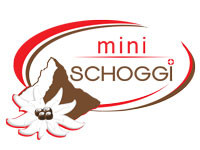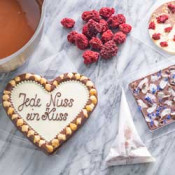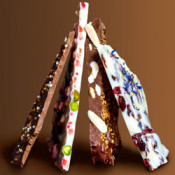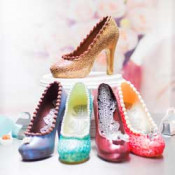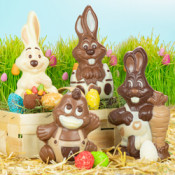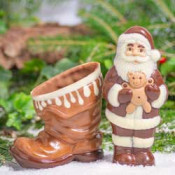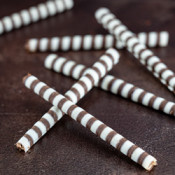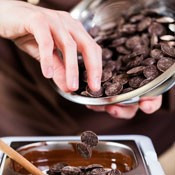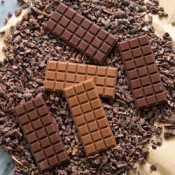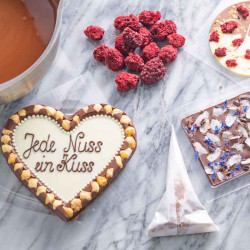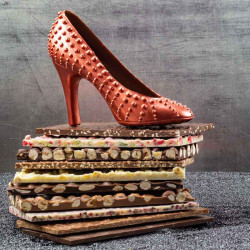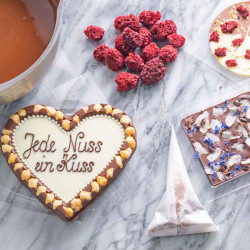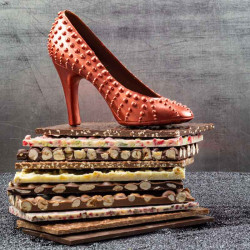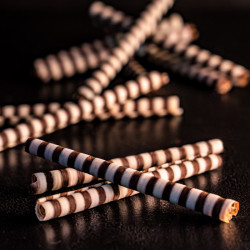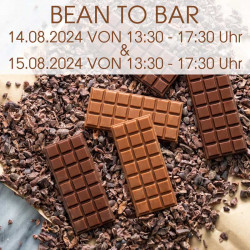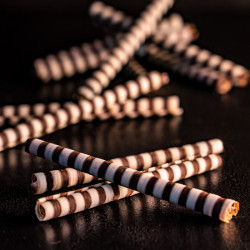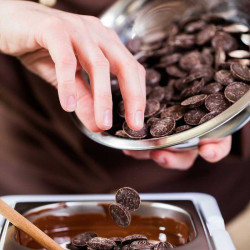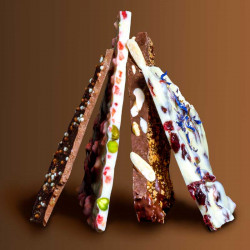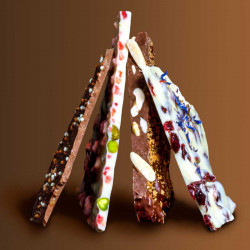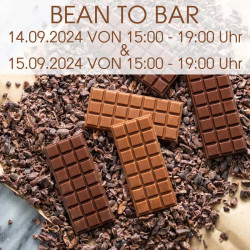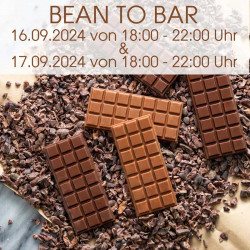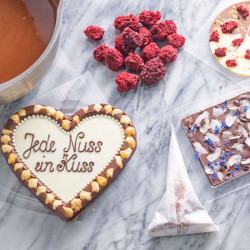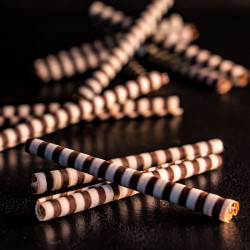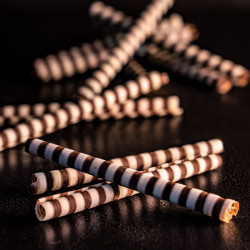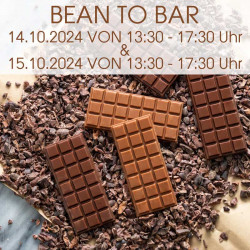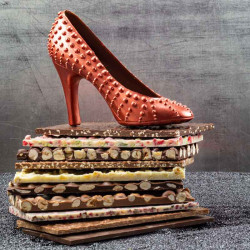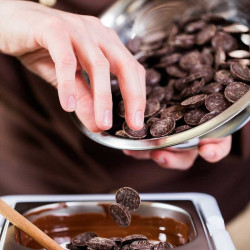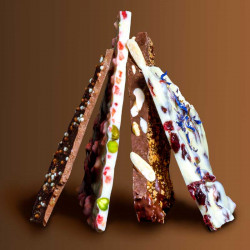Chocolate courses
Unterkategorien
Testimonials
Bruchschokolade – Positiv überrascht
Bin positiv überrascht, Kurs war sehr gut. Irgendwann werde ich wieder kommen. Kompetent, herzlich und lehrreich.Kuvertüre Temperierkurs – Nie langweilig
Der Kurs war super, wie übrigens jeder Kurs, den ich bei Euch besucht habe. Gute Kurse, auch verständlich für Anfänger. Wird nie langweilig und macht SpassKuvertüre Temperierkurs – Sehr gut erklärt
Ich fand ihn sehr lehrreich und interessant. Melina hat mit einfachen Worten alles gut erklärt. Mache gerne wieder einmal einen Kurs bei euch.Kuvertüre Temperierkurs – Inhaltlich perfekt
Kann nur sagen, für mich war der Kurs inhaltlich perfekt. Lehrreich und einfach super. Werde sicher nochmals einen Ihrer Kurse besuchen.Kuvertüre Temperierkurs 4h – Einfach toll
Der Kurs war sehr gut aufgebaut und man konnte sich Zeit lassen. Es war nie hektisch und alle Fragen wurden bestens beantwortet. Die Schokoladen sind sehr fein!Kuvertüre Temperierkurs – Interesse an Couverture
Spannend und lehrreich. Wenn ich das sagen darf einfach alltagstauglich, weil der Kurs aus meiner Sicht für alle ist, die Interesse an Couverture haben und für jeden verständlich ist.High Heels Kurs 4h – Toller Kurs
Der Kurs war super. Die Atmosphäre toll. Karin hat den Kurs gut angeleitet. Hätte gerne noch mehr Zeit für Austausch gehabt, um vom Profi zu lernen.Kuvertüre Temperierkurs – Auch für Laien gut erklärt
Ein wirklich guter Kurs, kompetent und auch für einen Laien gut erklärt. Sehr freundliche Kursleitung.Kuvertüre Temperierkurs – Empfehle ich weiter
Ich fand den Kurs sehr gut und alle meine Unsicherheiten über das Temperieren wurden geklärt. Ich empfehle den Kurs jedenfalls weiter!Chocolate courses
It comes in all shapes, colors, consistencies and qualities, it is the perfect gift for any occasion and one of the most famous products of Switzerland - chocolate. Originally it was drunk by the South American natives as a bitter drink called Xocolatl, then the drink reached Europe and through new processing methods then the chocolate as we know it today was created. Sweet, melt-in-the-mouth and delicious.
Whether in the form of chocolate bars, hot cocoa or great chocolate figures, the sweet mass inspires. So it's no wonder that chocolate and chocolate products are among the most popular gifts in the world. But the gift is only perfect when it is homemade.
A crunchy chocolate bar made of the best Swiss couverture, a sweet chocolate Easter bunny or brightly colored high heels made of chocolate, you can learn and make all this and much more with us. With a little practice, you can create great painted figures and beautifully shiny bars with different ingredients that go together perfectly. At our courses we will show you how all these creations are made and also succeed without any problems in your own kitchen.
Nowadays, chocolate is an everyday product, everyone knows the sight of the noble treat. But as with many foods, there is more work and more knowledge behind the processing than one might think. Hardly anyone knows how to turn a bitter, inedible bean into an aromatic, melt-in-the-mouth couverture, and the right tempering process to give the chocolate a beautiful gloss and the necessary stability is also a bit of a science. At our courses you will learn what is really behind the delicate and noble chocolate.
Learn everything about chocolate and its processing from professional confectioners and trained food technologists - with us it is possible. With scientifically based knowledge and a lot of experience, our course instructors introduce you to the world of chocolate. At our couverture tempering course, you will learn how to optimally prepare the couverture for molding into pralines, chocolate bars, decorations or hollow figures. Using various methods, you will ensure creations with a noble shine, a pleasant break and an excellent taste.
If you want to experiment with the cocoa bean rather than the finished couverture, the Bean to Bar course is for you. Under the expert guidance of our professional food technologist, you will put together your own desired couverture. Whether a fruity milk chocolate or a slightly sour dark couverture is desired, we will create your very own Bean to Bar creation.
Welcome to miniSchoggi
We live up to our name! At miniSchoggi you will learn the right way to work with chocolate and couverture. We show you how you can easily make delicious chocolate bars at home, cast sweet chocolate figures and how you can create your own Bean-to-Bar couverture from scratch. All of our courses are led by trained professionals. For example, professional confectioners will teach you how to make up a chocolate figure or how to cast an individually composed chocolate bar. A trained food technologist will show you how to make a delicious couverture from cocoa beans and a few other ingredients. In addition to a great deal of technical knowledge, our course instructors also bring many years of professional experience to the table. In this way, we guarantee you the best possible support and the passing on of sound knowledge. At our courses, you can ask all the questions that are on your mind!
With us, professional confectioners impart their knowledge of casting, molding and processing of couverture and chocolate. We make your dreams come true and show you how you can easily create your dream chocolate at home. For a very special experience, which always delights even our youngest visitors, we welcome you to our Santa Claus and Easter Bunny casting courses. And of course we also offer something for all those who take great pleasure in casting and decorating especially noble figures - an edible high heel shines in bright colors and is adorned with pearls and borders. With us, everyone will find a suitable sweet experience.
Chocolate has always fascinated the business founders Rebecca Odermatt and Thomas Ramseier. This is also the reason why the first courses focused on the professional tempering of couverture and could thus also be learned by people who were not professionally involved with the sweet treat. This was soon followed by other chocolate courses on Easter bunny and Santa Claus molding or chocolate bar making. As you can see, chocolate has been with us for a long time and so these courses will probably always be among our favorites.
Chocolate casting courses
If you would like to cast a funny Easter bunny or a Christmas Santa Claus, or create a chocolate bar according to your taste, then you have come to the right place! At our casting courses you will learn how to create sweet treats for yourself to enjoy and give away at home. In addition to a chocolate bar course, in which you can refine four chocolate bars with crunchy, fruity and exotic ingredients and a chocolate heart with a sweet message, we also offer a broken chocolate course. Here you will learn how to make your own broken chocolate. In addition to many recipes, you will also receive tips and tricks on how to pour the chocolate plates evenly and then divide them into beautiful bars. As a unique experience with the children or as preparation for many more figures, our Samichlaus and Easter Bunny casting courses are perfect. Proper polishing and make-up of the molds is part of the course, as well as pouring and adding a base. We provide a variety of molds, couverture types and colors. If you already have experience with figure casting, you are also welcome to join our Easter Bunny and Santa Claus workshop. In three hours you may make use of many different molds and already tempered couvertures and make up and cast three figures of your own. If you are a fan of noble shoes, the High Heels course will inspire you. After casting your own high heel, you will be allowed to create a chocolate bar on which the shoe will finally be placed. After practicing different patterns and testing colors, you may dare to try on the shoe right away. Decorated with mousse, painted with powder color and glossy varnish and completed with crispy and chocolate pearls, sugar decorations and noble Cake Lace borders, the shoe can also already be glued to the chocolate bar and nobly packaged.
Since the invention of the conching process by Rudolf Sprüngli, chocolate can be easily shaped into different forms. A wonderful feature when you look at the variety of chocolates available today. Simple chocolate bars, chocolate balls, Santa Clauses, Easter bunnies and other figures are now available in every supermarket and confectionery. But the chocolate tastes best when you shape it yourself.
Easter bunny casting
Experience something very special and create your own Easter bunny! Even children from the age of six can be creative and enjoy a wonderful Easter. The course is led by a professional confectioner. The course leader demonstrates exactly how the molds are properly made up, brushed and poured. The figures are then put on a base and cooled well before they are ready. Each participant is allowed to choose a chocolate mold from a large selection and make it up with different couvertures and colors according to his or her mood. Each person is also allowed to practice casting, so that a chocolate figure can easily be cast again at home. While the Easter bunnies then solidify in the refrigerator, you may fill seven small Easter eggs with fresh chocolate fillings, close them with couverture and finish them with various decorations. Finally, the Easter bunnies are unmolded, nobly packaged and taken home.
Santa Claus pour
Before Christmas, a delicious chocolate Samichlaus is simply a must! Under the guidance of our professional course leader, young and old may give free rein to creativity. With couverture and different colors, the shape you have chosen is made up sweetly. You have a large selection of different Samichläusen and in addition each person pours a great chocolate boot. Once you are satisfied with your work, you get to brush the mold with chocolate, pour it out and add a bottom. While the first figure is setting in the refrigerator, you can decorate and pour the second mold. Then the first Sami lice are ready to be molded and wrapped. At the end of the course, in addition to your own two chocolate figures, you will also take home a lot of new knowledge about working with chocolate.
High Heel Casting Course
The only thing better than a stunningly beautiful high heel is a stunningly beautiful high heel made from the best Swiss couverture! In this course, you will be able to cast a delicious chocolate high heel under the guidance of a professional confectioner. Afterwards, you can decorate it with subtle or eye-catching designs, just the way you like it best. With noble powder colors you give your shoe the perfect shine and a radiant color. Use pearls, sugar decorations, chocolate and beautiful cake-lace borders to create your very own dream shoe. In addition, you will cast your own chocolate bar with delicious ingredients so that your high heel can finally be glued on and securely packaged. We create more beautiful high-heels than any shoe designer - and they're delicious, too!
Other chocolate courses and pouring at home
Homemade chocolate bars, Easter bunnies, high heels and Santa Clauses have one thing in common: the couverture used for them must be correctly tempered, otherwise the end products will not be beautiful and will not come out of the mold. The project stands and falls with the couverture, so it is important to always use high-quality couverture and to use it correctly.
Chocolate courses
Professional tempering has to be learned, because only a correctly processed couverture can also be poured into beautifully shiny chocolate figures, fine chocolates and chocolate bars with a perfect break. Trained confectioners will show you what to look out for and how to prepare white, dark and milk couverture for later use using the tablier and inoculation method. And if you want to delve deeper into how chocolate is made, our Bean to Bar course is for you. A professional food technologist and home chocolatier will introduce you to different cacao beans and their characteristics, and help you create the chocolate of your dreams. After you select and prepare your preferred cocoa bean, you get to mix it with various ingredients. Depending on the desired cocoa content and sweetness, you add more or less cocoa butter and sugar. If you are a fan of milk chocolate, a little milk powder should not be missing. On the second evening of the course, the time has come. Your own chocolate is tempered and poured into couverturedrops or small chocolate bars. These can also be refined with crunchy, fruity and exotic ingredients, so you bring home sweet treats as well as a lot of new knowledge.
Couverture tempering course
To make fine chocolates and hollow figures or to mold delicious chocolate bars, the couverture used must be tempered correctly. If this is neglected, the chocolate often sticks to the mold, possibly forming lumps and the finished products have a gray haze instead of a beautiful shine. To prevent this from happening, a professional confectioner will show you how to easily temper all types of couvertures at this course. You will learn the inoculation and the tabling method and temper white, dark and milk couverture right at the course. So you are perfectly prepared for sweet creations at home. In the course program, which you will receive at the course, you will find detailed instructions and tips and tricks - so nothing can go wrong.
From Bean to Bar
As seen in the Bean to Bar course, there is a lot of work before creating delicious figurines and bars with the finished couverture. The cocoa beans must be harvested, sorted, fermented, roasted and processed. The individual ingredients are separated from each other and mixed with other ingredients in a specific ratio. Conching and tempering must not be forgotten under any circumstances. But how did the process from bitter cocoa bean to melt-in-the-mouth chocolate come about in the first place?
Bean to Bar Course
Cocoa beans, once freed from the shell, fermented and separated from the pulp, must be sorted, dried, roasted and crushed. Only then have they developed a delicious cocoa aroma and can be combined with other ingredients. With these, they are finely ground and mixed in the so-called melangeur. Conching, the rolling with heavy stone rollers, makes the chocolate wonderfully melt-in-the-mouth, and after tempering it can be poured into various molds. What is normally done in large factories, you can experience for yourself with us. How your chocolate turns out is up to you. You choose your favorite from a large selection of different already fermented and roasted beans and prepare the beans for further processing. What else goes into your chocolate is up to you. Add a little sugar and cocoa butter to create a dark chocolate with an intense cocoa flavor and a distinct variety of aromas appropriate to the selected bean. If you choose sugar, cocoa butter and whole milk powder as other ingredients, you will obtain a noble and aromatic milk chocolate. With the support of our dedicated food technologist and a detailed course program, you will realize your dream couverture.
Chocolate bar course
The classic among our casting courses and a perfect introduction to working with chocolate. In the chocolate bar course, you are allowed to pour four bars of your own from the best Swiss couverture. To help you create the chocolate of your dreams, we provide you with a wide selection of crunchy, fruity and aromatic ingredients that you can add directly to your chocolate. With dried flowers, crispy pearls and many other decorations you may then give your chocolate the perfect look. In addition, you pour your own chocolate heart with noble edge decorations and plenty of space for a personal message. This is how you create your dream chocolate and noble gifts.
History of chocolate
The history of chocolate goes back very far, already around 1000 BC the beans of the cacao fruit were used. The oldest traces were found in the lowlands of the Gulf of Mexico. The Olmecs, a rather unknown people until today, used to live there. In pots and bowls of the Olmecs a brown substance was found, which contained theobromine, an ingredient of chocolate that has a stimulating and mood-lifting effect on humans. The cacao or the drink brewed from it was called "Kakawa".
Later, the Mayas brewed an extremely bitter and, from today's perspective, only slightly tasty drink from the noble beans. Seasoned with chili pepper and stirred until foamy, the cocoa mixture was enjoyed. Other preparations, for example with corn and spices, were also very popular with the natives. As in South America, the pulp was processed into fruit juice or fermented into alcohol. The fact that beans were used as a means of payment and transported over long distances from plantations shows how highly they were valued even back then.
The Mayans traded cacao among themselves and also with the Aztecs. Here, too, the enjoyment was mainly reserved for the nobility. Even more than with the Mayas, the cacao bean was used as a means of payment. A tomato or an avocado corresponded to about one cacao bean, for a rabbit one had to pay 100 cacao beans. Since scales were still unknown at that time, a certain number of beans was reckoned with, but some varieties were considered more valuable than others. In order to obtain many beans, the Aztecs demanded them as a tax from their subjects. Of course, the Aztecs also processed cocoa beans and drank them with spices, and the drink was also used for various rites.
When Spanish conquistadors first came into contact with the indigenous people, they also got to know the cocoa drinks and porridges, but they were often not very enthusiastic about them. Only with adapted ingredients did the mixture become more popular with the conquerors as well. Instead of chili pepper, they mixed cane sugar, pepper, and sometimes cinnamon and anise into the cocoa drink. Exactly when cocoa came to Europe is still unclear. The first record dates back to 1544, but it was not until decades later that the noble beans were actively imported from Central America.
Sweetened and flavored with various spices, cocoa found its way into the noble houses of Spain, Italy and later all of Europe. Various ingredients were experimented with, so the hot drunk brew was prepared and enjoyed with vanilla, jasmine, lemon peel or cinnamon.
In England, hot chocolate also became accessible to the lower social classes for the first time. Coffee houses sold tea, more expensive hot chocolate and even more expensive coffee. It was only with new processing techniques and industrialization that the noble drink became more affordable.
By pressing the cocoa beans, it was possible to separate the cocoa butter from the remaining cocoa mass. This greatly simplified the production of cocoa powder for hot beverages. In addition, the steam engine was now also used in the chocolate industry. With its help, more chocolate could be produced in a shorter time, which was then called steam chocolate.
The production of chocolate not only became faster and cheaper, but the quality also increased. Suchard's invention, the mélangeur, made it much easier to mix sugar and cocoa beans, or cocoa powder, together. Chocolate bars were already being produced at this time. These were still very different from what we know by that name today. They were very tough and had to be pressed into the bar molds. The structure was very granular and the melting point was much higher, so the chocolate did not melt by itself in the mouth. Nevertheless, the first chocolate bars had great success. In the beginning, they were sold mainly in Italy by traveling merchants, the cioccolatieri.
Since more cocoa could now be processed, things also changed in the growing countries. Since the indigenous people were better protected by the pope and at the same time many of them had already fallen victim to disease and battle, more and more slaves were imported from Africa. In addition, new plantations were also established in Central America, South America and Africa.
In 1848, another breakthrough was made in the field of chocolate processing. A British company added cocoa butter, previously considered a waste product in the production of cocoa powder, to its chocolate instead of water. This made the mass softer and it could also be poured into molds. Thus, for the first time, chocolate became a pleasure even without many ingredients and flavorings.
At that time, there were four different types of chocolate on the market. While chocolate bars made from cocoa and sugar, which now came from European sugar beets, and bars made from cocoa, sugar and spices served primarily as a stimulant, chocolate mixed with starch (for example sago) was used as a tonic. Chocolate was also still used in medicine. Even among the indigenous peoples of Central America, chocolate was considered a remedy for measles and was given to pregnant and childbearing women as a painkiller. Now in the chocolate were processed medicinal plants, but also mercury, which was so sold in pharmacies to help against sore throat, anemia or syphilis.
The next innovation was not long in coming, because soon milk chocolate was invented. Henri Nestlé's invention, milk powder, was used by Daniel Peter to give his chocolate a special flavor. Again, another company actually beat you to it, Jordan and Timaeus from Germany, but it was the Swiss manufacturers who really made milk chocolate famous.
The last invention that turned the chocolate world upside down came from the Swiss Rodolphe Lindt. He invented the conche and with it the process of conching. By rolling the chocolate in granite basins for hours, heat is generated. This causes another part of the water in the cocoa beans to evaporate and, with it, various flavors and smells to evaporate after a while. After conching, the chocolate is a matte liquid that literally melts in your mouth. The lumpy and still rather heavy chocolate of the past has been replaced by a smooth melting chocolate with a pleasant sheen. Unpleasant odors and bitter substances were also reduced by conching. But desirable flavors and fragrances can also be lost through conching. Thus, this process and its duration are still of great importance to the chocolate industry today.
In addition to different conching times, people are nowadays increasingly experimenting with flavors and other ingredients. Many large and small producers offer fruit and spice chocolates in addition to pure chocolates. This ranges from the now familiar orange or caramel bars to chili chocolate and exotic creations with jalapeños and strawberry pieces.
In addition to creative combinations, organic chocolates and fairly produced products are also becoming more and more fashionable. This is a particularly important movement because despite their expertise and hard work, most cocoa farmers barely earn enough to support their families. Child labor is used on many cocoa plantations, and the cocoa market is dominated internationally by a few large companies that set the cocoa bean price. By buying fairly produced chocolates and supporting Fairtrade, you are helping cocoa farmers around the world build a better life for themselves and their families.
Chocolate processing
Since man began harvesting and processing cacao fruit, the exact method of processing has changed again and again. More than 3,000 years ago, the Olmecs from the Central American lowlands were already using the beans of the cacao fruit, presumably grinding and mixing them with water to make a drink. More precise information is available about later peoples. In South America, the pulp, the white pulp surrounding the beans, was separated from the beans and enjoyed as a sweet refreshment or fermented as alcohol. The Mayas did the same, but they also used the beans. These were ground to a grainy mass and mixed with water and chili to a noble - from today's point of view rather undrinkable - drink. This was served to kings and rulers, and was also consumed as a remedy and painkiller.
The Aztecs valued the bean even more. For them, it was also a popular means of payment; an avocado or a large tomato was roughly equivalent to a cocoa bean. To fill the royal treasury, taxes were demanded from the subject territories in the form of the brown beans.
Despite its high value, the cocoa bean was also readily consumed here. Mixed with corn and water, a nutritious porridge was created; in liquid form with chili, the cocoa bean continued to be used as a stimulant and remedy, but also as a ritual drink and sacrifice to the gods.
The European seafarers, who first came into contact with the various forms of cocoa food, were not very enthusiastic. It was not until chili was replaced by cane sugar that the popularity of the drink, previously known to the natives as xocolatl, increased.
It took a while for the cocoa bean to reach Europe, and it was not until decades later that the beans were actively imported. But then they spread very quickly, as in their country of origin, they were considered a particularly noble treat, reserved for nobles and kings. Of course, the bean was still very bitter and not really a treat, but finely ground, mixed with hot water, cane sugar and vanilla, it became a real luxury drink.
New combinations quickly emerged; mixed with elderflower, pepper, cinnamon or anise, the drink spread throughout the noble houses of Europe. In England, the lower social classes also had the opportunity to drink cocoa for the first time. This was because industrialization brought with it the machine processing of cocoa beans. The fine powder no longer had to be made by hand and cocoa became cheaper - but still far from cheap.
In Italy, the cioccolatieri, traveling merchants who sold the grated, sticky cocoa mass as a solid sweet, spread. They experimented with different shapes, the viscous mass was pressed into praline or bar shapes. This chocolate is hardly comparable to what is sold in the supermarket today. Eating the chocolate was difficult, because it did not melt at body temperature. The tough lump had to be chewed and was also sticky and bitter.
This became a little better by adding cocoa butter instead of water. The lumpy mass became a pourable chocolate. In the meantime, chocolate manufacturers all over Europe were experimenting with cocoa, but it was the Swiss Rudolf Sprüngli who had the brilliant idea - or a happy accident. Legend has it that one evening he forgot to turn off the roller for mixing the ingredients, so it kept running for an entire weekend. When he then returned to work, the sandy mass had become a shiny, melt-in-the-mouth chocolate.
The real chocolate as we know it today was born. The duration of the conching process and other processing steps vary greatly, of course, depending on the application of the chocolate and the properties of the cocoa beans used. Conching also causes many aromas to disappear - both unpleasant and pleasant ones. Therefore, a long conching time does not always indicate good quality.
Since this last great invention, mainly ingredients were exchanged and combined in a new way, so many new individual products and flavors were created. Orange, nougat or caramel chocolate, chocolate-covered ice cream, chili pralines or so-called raw chocolate came onto the market. Various companies are always trying to release new creations and always surprise with special combinations.
With us, you too can become an inventor. Combine your selected cocoa beans with special ingredients at the Bean to Bar course and enjoy your very own chocolate. With the help of our food technologist, your chocolate will have the desired flavor, which can also be complemented with additional crunchy and fruity ingredients when poured into chocolate bars. Let your creativity run wild and become a chocolate professional with us!
Properties of a good chocolate
In addition to the production circumstances, the result is of course also of great importance. How should a high quality chocolate be? This question is not easy to answer and ultimately good chocolate is also always a matter of taste, but some evaluation points you should consider when choosing chocolate.
Incorrectly processed or stored chocolate can already be recognized by its appearance. If a gray haze stretches over the treat or if gray dots or streaks can be seen on it, this indicates that the chocolate has been treated incorrectly. But this does not mean that the chocolate is of poor quality or tastes bad. Many defects caused by incorrect storage do not affect the taste.
A good chocolate has a beautiful sheen when processed as a praline or chocolate bar. If you rub a small piece of it between your fingers, you should already be able to smell different aromas. If a part of the chocolate bar is broken off or bitten, a nice crack should be heard.
Now a small piece of the chocolate is tasted. To do this, let the chocolate melt on your tongue and rub it a little on the palate. Also pay attention to the feel. Does the chocolate melt pleasantly on the tongue? Are there any granules in it that indicate improper processing? Inhale through your mouth in between and try to smell different aromas. With a good chocolate, you will discover other aromas in addition to the typical cocoa notes. For laymen, these are often difficult to find and name, but with a little practice, you'll soon get the hang of it.
All types of chocolate should not taste of sugar. If you find no flavors, but only a strong sweetness, it is a cheaply produced chocolate whose more expensive ingredients, such as cocoa mass and cocoa butter, have been partially replaced by sugar. In light and milk chocolates, caramel notes may be present instead. Depending on the variety, milk aromas can also be detected.
Good dark couvertures are often particularly rich in flavors. In addition to the typical slightly bitter taste, they can also be slightly sour, fruity or even floral. Try small pieces of different chocolates or couvertures and compare them. Differences will be noticed quickly and soon you will be able to distinguish different qualities. You can also learn how to taste, recognize and produce high quality chocolates and couvertures at our courses.
Chocolate courses at miniSchoggi
With one of our chocolate courses we take you on a journey into the sweet world of chocolate! Whether alone, with the family or in a group we guarantee you a lot of fun and joy in one of our chocolate courses.
Have you always wanted to take a course on chocolate and strengthen your know-how in these areas or even learn something new right from the start? Our various chocolate courses combine the practice with the theory and thus ensure instructive and at the same time sweet hours. All our chocolate courses are supervised by the professional course management, because very good care is close to our heart.
Our chocolate courses are divided into different subcategories so that there is certainly something for everyone. In addition to the classic chocolate courses such as chocolate figurines / bars cast and make chocolates, we also offer chocolate specialist courses.
Our praline courses are divided into three different groups: the classic praline course, the praline atelier and the advanced praline making. The chocolate courses are open to the public and we welcome adults and teenagers from 12 years old.
In the chocolate molding course, we offer molding of Easter bunnies, Santas as well as high heels in addition to the classic "bar molding". Easter bunnies and Santas are seasonal and also good for our younger audience (children from 6 years) as well as family outings.
The chocolate courses such as "Couverture Tempering Course" as well as the "Bean to Bar" chocolate course, are aimed at people who want to deal with the subject of chocolate in detail and very intensively. Therefore, we offer the chocolate course "Couverture Tempering Course" and the "Bean to Bar" course for young people from 13 years.
We offer our chocolate courses in Zurich Adliswil and in Bern. Our courses can be paid in advance, on account, Paypal or directly with your credit card. All information will be sent to you by e-mail.
miniSchoggi Onlineshop
In our online store you will find all the necessary tools for the production of various treats at home, as well as various couvertures of the best Swiss quality. We offer a wide selection of large and small bar molds and even chocolate bars can be made very easily. Would you like to cast at home for Easter, Advent or simply as a small gift a chocolate hollow figure, you will find it with us. In our online store as well as in our store in Adliswil, we have Easter bunny, Santa Claus, animal and even some other figurine molds, such as a VW beetle or a boot ready and waiting to be poured by you. The molds come with matching clamps, so they can be easily attached to each other. Pick your favorite mold, choose the matching couverture and you're ready to go.
Felchlin Couverture
Felchlin offers a somewhat larger selection of dark chocolates, the Maracaibo variety was even named the best dark chocolate in the world. The white couverture convinces with an intense caramel aroma and becomes slightly more yellow than other varieties when poured out, the milk couverture is also delicious and tastes typically of high-quality milk chocolate.
Lindt Couverture
The Lindt envelopes meet almost every taste. They are among the most popular couvertures and for good reason. They are all very easy to work with, the white couverture carries a beautiful light color, which for example makes the eyes of the chocolate hollow figures shine, the milk couverture tastes pleasantly of caramel and the dark chocolate is also very popular, because it is not as bitter as other dark couvertures.
Läderach Couverture
Läderach also offers the best Swiss couverture. The dark couverture carries a pleasant, slightly bitter taste, while the light chocolate is wonderfully sweet. The milk couverture differs from other couvertures of the same type with its subtle milk flavor and tastes a little less like caramel.
With this large selection, we offer something for every taste. Once you have found the right couverture, all that remains is to process it. For perfectly shiny end products with a crunchy break, the couverture must first be tempered. This process ensures the right fat crystal formations in the chocolate, which give it the necessary stability and a pleasant shine. You will find instructions on the inoculation method on our blog in a moment. If you want to learn more about tempering and the processes behind it, you are welcome to attend one of our couverture tempering courses. There you will also learn how couverture is tempered by tabling, a particularly sensual work.
Praline courses
Of course, many other treats can be poured from chocolate. Especially noble, for example, are homemade chocolates. Of course, it is easier to make these treats if you already have pre-molded hollow bodies, but casting your own hollow praline bodies opens up completely new possibilities and is incredibly fun. In our praline basic course, you will be shown how to pour the molds correctly, and in the advanced praline course, you will even be allowed to pour your own hollow bodies. These can also be finished with different cocoa butter colors.
Cake courses
Chocolate is also a recurring theme in our cake courses, albeit somewhat in the background. In the basic cake course 2, we make elegant decorations from chocolate, for example, great chocolate spirals, a large chocolate flower or small decorative plates for the cake. Even the edge of the cake can be made from chocolate!
